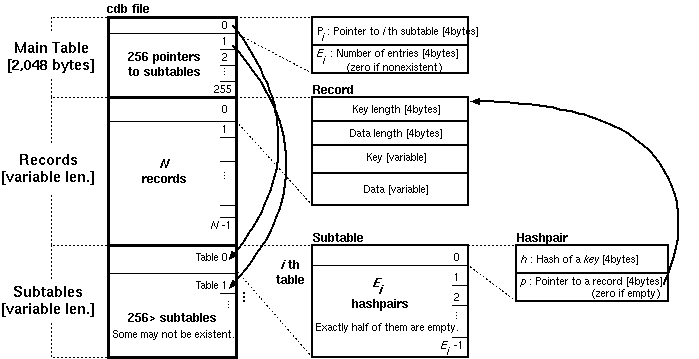
Fig. 1: Cdb File Structure
Constant Database, known as cdb, is an elegant data structure proposed by D. J. Bernstein. It is suitable for looking up static data which is associated with arbitrary byte sequences (usually strings). Although DJB already explained this in his cdb page, it is not easy to implement this because his document lacks some important information such as the number of each subtable. Here I tried to illustrate it for those who try to develop or extend a cdb implementation.
A cdb has a number of records which has a key and a datum, each of which can be in variable length (up to 4GBytes). The file format is designed for locating a record with as few seeks as possible. Although a cdb itself seems to have a flat list of key and datum pairs, in fact it has 2-level hierarchical tables to lookup. A cdb file consists of roughly three parts. Actual data which consist of an arbitrary number of key/datum pairs are sandwiched between two lookup tables. The first lookup table has always fixed size (2,048 bytes). The second lookup table is divided into at most 256 subtables, each of which has a variable number of entries, and is accessed from the pointer stored in the first table. (Fig. 1)

Each key/value pair is referred to by a small data structure which is stored in the second table. Here we call it a "hashpair" for convenience.

I measured the lookup time and file size for randomly created records. The test program is dbmperf.c. You need gdbm and Samba source to build. Here is the result. Times are in seconds. File sizes are in bytes.
| # of records | 10,000 | 100,000 | 1,000,000 |
|---|---|---|---|
| gdbm | 0.070 | 0.862 | 9.141 |
| tdb | 0.035 | 0.358 | 3.904 |
| cdb | 0.028 | 0.288 | 3.068 |
| # of records | 10,000 | 100,000 | 1,000,000 |
|---|---|---|---|
| gdbm | 1,359,459 | 14,316,032 | 139,738,235 |
| tdb | 1,081,344 | 10,764,288 | 107,667,456 |
| cdb | 986,108 | 9,798,122 | 98,005,628 |
Σ Ei = 2 * (the total number of records)
Here is a sample implementation of cdb in Python. The plain text version is here.